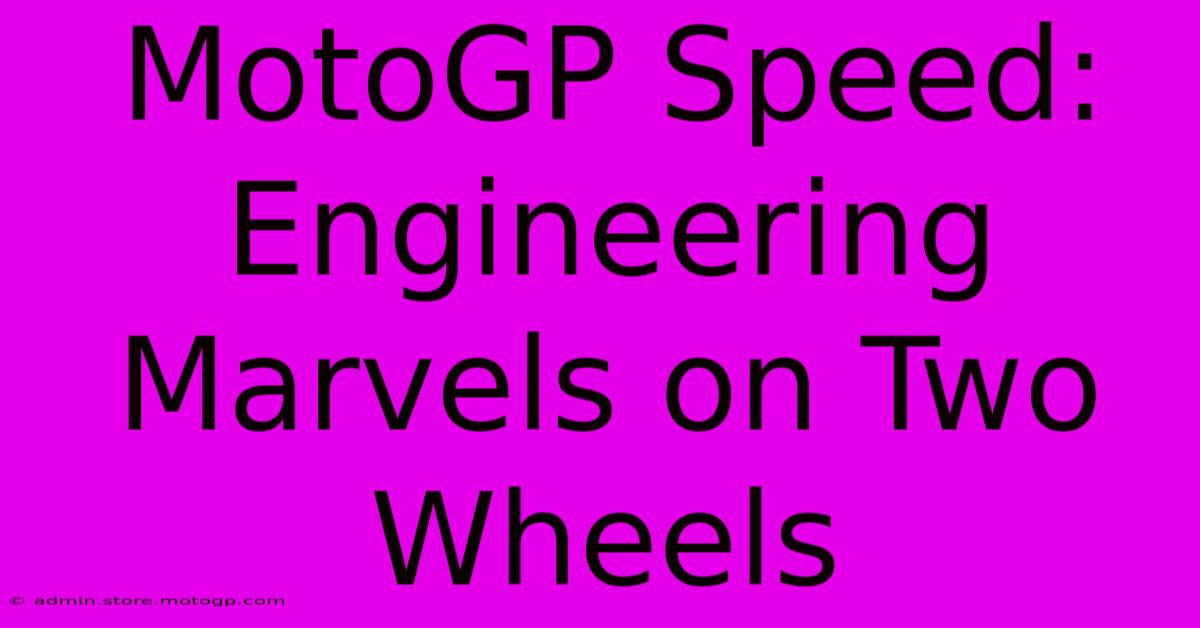MotoGP Speed: Engineering Marvels On Two Wheels

Table of Contents
MotoGP Speed: Engineering Marvels on Two Wheels
MotoGP. The name alone conjures images of breathtaking speed, heart-stopping overtakes, and the roar of powerful engines. But beyond the drama and spectacle lies a world of cutting-edge engineering, where milliseconds matter and innovation drives the pursuit of ultimate velocity. This article delves into the technological marvels that make MotoGP bikes the fastest and most sophisticated motorcycles on the planet.
The Engine: A Symphony of Power and Precision
At the heart of every MotoGP machine is a finely-tuned engine, a testament to human ingenuity. These aren't your average motorcycle engines; they are highly-specialized, screaming powerhouses typically boasting a displacement of just under 1000cc. Four-stroke engines dominate the scene, delivering phenomenal horsepower figures – often exceeding 260bhp – and reaching stratospheric RPMs.
Key Engineering Features:
- Lightweight Materials: Titanium, magnesium, and carbon fiber are extensively used to minimize weight, crucial for achieving maximum acceleration and handling.
- Sophisticated Fuel Injection: Precise fuel delivery systems ensure optimal combustion, maximizing power output and efficiency.
- Pneumatic Valves: Advanced valve actuation systems utilize compressed air to precisely control valve timing, further enhancing performance.
- Seamless Gearboxes: The seamless shift technology allows for incredibly fast gear changes without interrupting power delivery, crucial for maintaining speed through corners.
Aerodynamics: Cutting Through the Wind
Speed isn't just about engine power; it's also about minimizing aerodynamic drag. MotoGP bikes are meticulously designed to slice through the air with minimal resistance. Aerodynamic wings, once a rare sight, are now integral parts of the machines, generating downforce that keeps the bike glued to the track at high speeds, allowing for greater cornering speeds.
Aerodynamic Innovations:
- Winglets and Fairings: Complex shapes and strategically placed winglets reduce drag and increase downforce, maximizing grip and stability.
- Computational Fluid Dynamics (CFD): Sophisticated computer simulations are used to optimize aerodynamic performance, refining the design for optimal efficiency.
- Wind Tunnel Testing: Extensive wind tunnel testing plays a crucial role in validating and refining the aerodynamic designs.
Chassis and Suspension: The Perfect Handling Package
The chassis and suspension system are equally critical to a MotoGP bike's performance. These components work in harmony to provide exceptional handling and stability at extreme speeds. Sophisticated suspension systems allow riders to navigate challenging corners with precision and confidence, even at speeds that would be unimaginable on a standard motorcycle.
Key Chassis and Suspension Technologies:
- Lightweight Chassis: Usually made from carbon fiber or aluminum, offering exceptional strength-to-weight ratio.
- Advanced Suspension Technology: Sophisticated semi-active or fully active suspension systems constantly adjust to changing track conditions and rider input.
- Optimized Geometry: Precise geometry and weight distribution are essential for achieving optimal handling and stability.
Electronics: The Brains of the Operation
Modern MotoGP bikes are equipped with incredibly sophisticated electronics packages that act as the "brains" of the machine. Electronic rider aids, such as traction control, launch control, wheelie control, and cornering ABS, help riders maximize performance and maintain control even in extreme conditions. These systems constantly monitor various parameters and make adjustments to optimize performance and safety.
Electronic Rider Aids:
- Traction Control: Prevents wheelspin, especially crucial during acceleration.
- Wheelie Control: Prevents the front wheel from lifting off the ground during acceleration.
- Launch Control: Optimizes acceleration from a standstill.
- Cornering ABS: Prevents lock-up of the wheels during braking in corners.
The Human Factor: Rider Skill and Synergy
While the engineering marvels are undeniable, the human element remains paramount. The skill and precision of the riders are just as crucial to achieving ultimate speed. The rider and the machine must work in perfect synergy to extract maximum performance. The rider's ability to adapt to changing track conditions, manage tire wear, and push the machine to its limits is critical to success.
In conclusion, MotoGP speed is not just about raw power; it's a testament to the combined efforts of engineers, designers, and riders who constantly strive for innovation and perfection. The pursuit of ever-increasing speed and performance drives the development of cutting-edge technologies that push the boundaries of what's possible on two wheels. The next time you watch a MotoGP race, appreciate not just the thrilling spectacle, but also the incredible engineering marvels that make it all possible.

Thank you for visiting our website wich cover about MotoGP Speed: Engineering Marvels On Two Wheels. We hope the information provided has been useful to you. Feel free to contact us if you have any questions or need further assistance. See you next time and dont miss to bookmark.
Featured Posts
-
The Science Of Winning Tnt Moto Gp
Feb 21, 2025
-
Austin Gp Concert Get Your Adrenaline Pumping
Feb 21, 2025
-
The Formula 1 Shuttle Your Vip Pass
Feb 21, 2025
-
Moto Gp Sprint Racing Closer Faster More Intense
Feb 21, 2025
-
Moto Gp Austin Dates The Race Is On
Feb 21, 2025
